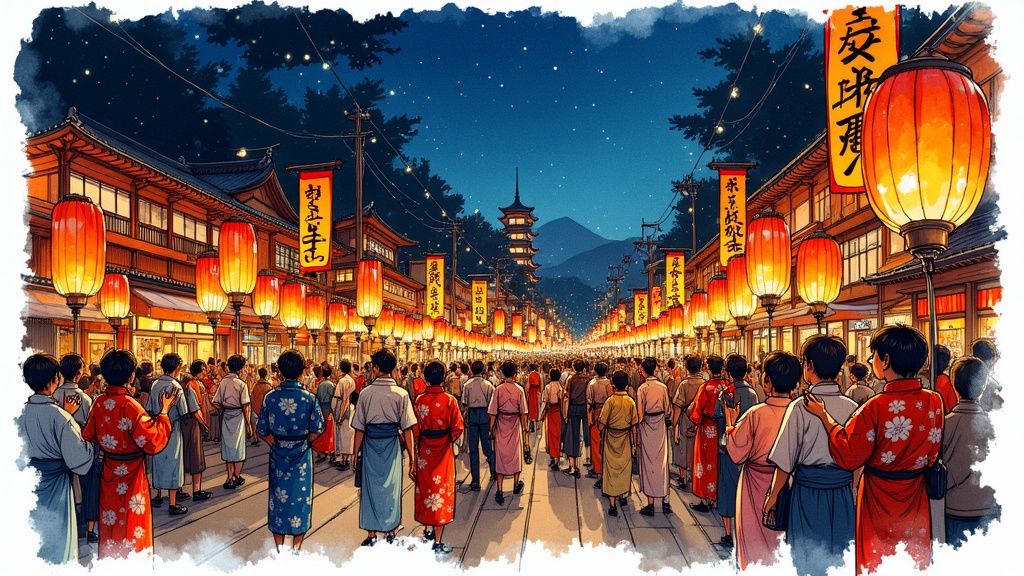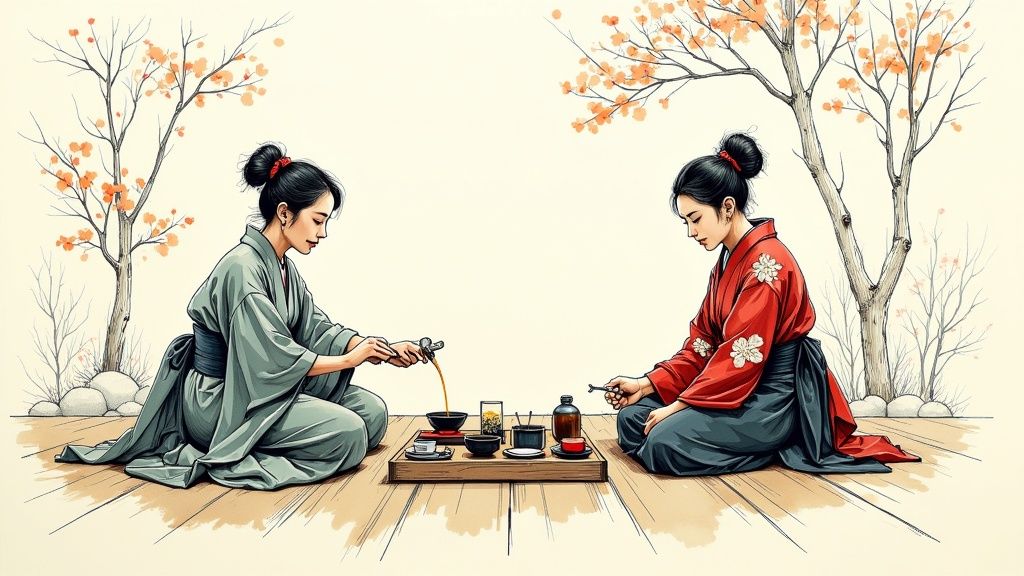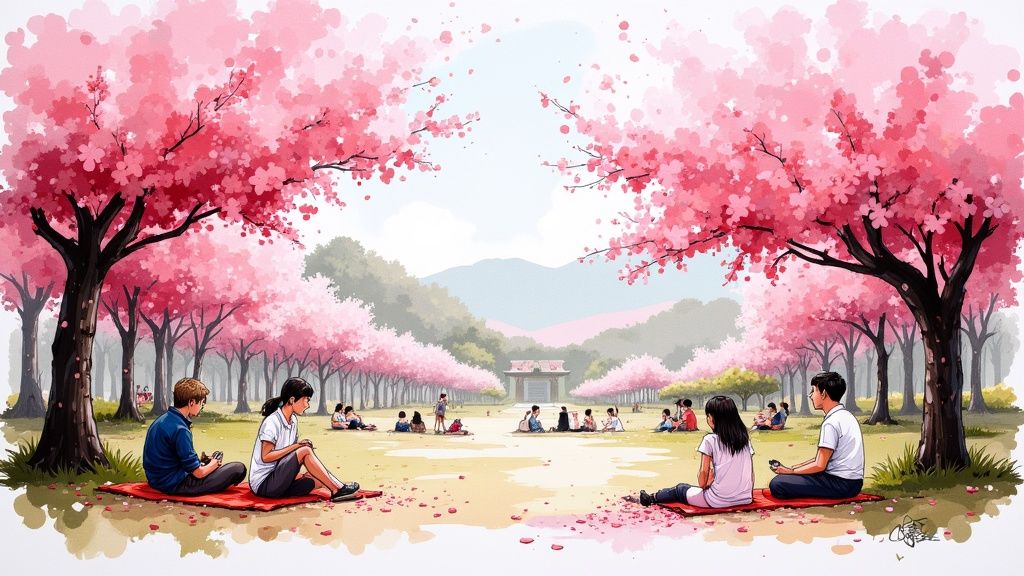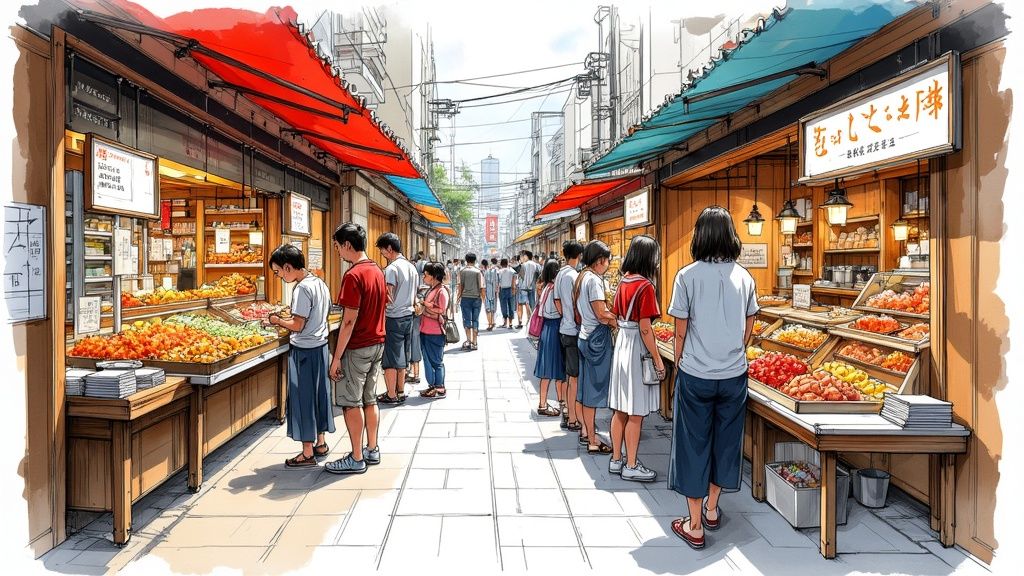The Living Heritage of Japanese Cultural Festivals

Every year, between 100,000 and 300,000 festivals take place across Japan, breathing life into centuries-old traditions. These celebrations generate over 530 billion yen annually, but their true value goes far beyond economics. Each festival tells a unique story, connecting modern Japanese communities to their ancestors through music, dance, costumes, and shared rituals that have been carefully passed down through generations.
UNESCO Recognition: A Testament to Cultural Significance
The global importance of Japanese festivals is reflected in their recognition by UNESCO as Intangible Cultural Heritage. A prime example is the collection of 33 "Yama, Hoko, Yatai" float festivals, which showcase Japan's masterful craftsmanship and community spirit. This international acknowledgment has helped preserve these traditions while drawing visitors from around the world who want to experience authentic Japanese culture firsthand.
Balancing Tradition and Modernity
Festival organizers face the ongoing challenge of preserving authentic traditions while meeting contemporary needs. Many have found creative solutions, such as adding digital ticket systems and multilingual guides without compromising the festivals' core elements. Some events now feature modern safety measures and improved accessibility, ensuring that both locals and international visitors can fully participate while maintaining respect for age-old customs.
The Economic and Social Impact of Festivals
Beyond their cultural significance, these festivals strengthen local economies and communities. They create jobs, boost tourism, and support traditional craftspeople who make everything from festival costumes to ceremonial objects. More importantly, festivals bring people together – neighbors work side by side for months to prepare elaborate displays and performances. Through shared preparation and celebration, these events forge bonds between participants and help preserve Japanese cultural identity. The rhythmic drumming, graceful dances, and brilliant costumes do more than entertain – they connect people to their heritage and each other in ways that resonate across generations.
Time-Honored Traditions: Ancient Festivals That Still Captivate

The mesmerizing costumes of the Aoi Matsuri and daring feats of the Onbashira Festival offer windows into Japan's rich cultural heritage. These ancient celebrations, many now recognized by UNESCO as Intangible Cultural Heritage, continue to draw both locals and visitors year after year. Their enduring appeal shows how these festivals remain meaningful by connecting people to centuries-old traditions while staying relevant today.
The Aoi Matsuri: A Journey to Heian-Era Japan
Every May 15th, the streets of Kyoto transform as over 500 participants in elegant Heian-era (794-1185) costumes process through the city during the Aoi Matsuri. The festival brings history to life through carefully recreated details – from the deep blues and purples of traditional robes to the haunting melodies of ancient court music. As the parade winds through modern streets, it creates a living link to Japan's imperial past. This yearly tradition does more than preserve historical dress and customs – it helps pass cultural knowledge from one generation to the next.
The Onbashira Festival: 1,200 Years of Thrills and Tradition
The Onbashira Festival in Nagano Prefecture's Suwa region has tested courage and built community bonds for over 1,200 years. Held every six years, this unique celebration centers on felling massive cedar trees and riding them down steep hillsides – a practice rooted in renewing the Suwa Taisha Shrine. Beyond the heart-stopping spectacle of participants perched on tumbling logs, the festival requires extensive planning and brings the whole community together. This shared effort strengthens local ties and cultural identity through a time-tested tradition.
Adapting Ancient Rituals for the Modern Age
While these festivals honor age-old customs, they also evolve thoughtfully to meet current needs. Organizers work to maintain authenticity while adding safety measures, digital ticketing systems, and resources for international guests. Many festivals now provide guides in multiple languages to welcome visitors from abroad. You can learn more about how Japanese festivals adapt in our article about experiencing the magic of Japanese cherry blossom festivals. Though changes sometimes spark debate, they help ensure these cherished traditions can be shared with future generations.
Summer Magic: The Heart of Festival Season

When summer arrives in Japan, the streets come alive with festive energy as communities gather to celebrate centuries-old traditions. Even in the sweltering heat and humidity, people join together for vibrant cultural festivals across the country. Two of the most captivating summer celebrations are the Gion Matsuri and Awa Odori festivals, each offering its own distinct window into Japanese heritage and community spirit.
Gion Matsuri: A Month of Purification and Celebration
The Gion Matsuri fills Kyoto's streets throughout July with a month-long celebration steeped in history. Dating back to 869 C.E., the festival began as a ritual seeking divine protection during a devastating plague. While some aspects have naturally evolved over the centuries, the core traditions of purification and communal celebration remain firmly intact, connecting modern participants to their ancestors' customs.
The festival reaches its peak during the Yamaboko Junko, when enormous decorated floats parade through the city streets. These towering structures, some reaching several stories high, showcase incredible craftsmanship while bringing neighborhoods together. Each local community takes great pride in creating and operating their own unique float, working side by side to maintain their piece of this living tradition. For many participants, the friendly competition between neighborhoods adds an extra layer of excitement to the festivities.
Awa Odori: Dancing Through the Streets of Tokushima
Mid-August brings a different kind of energy to the streets of Tokushima during the Awa Odori festival. Instead of massive floats, this celebration fills the city with the rhythmic movement of thousands of dancers. As traditional music echoes through the streets, performers in vibrant costumes create waves of synchronized motion that often sweep up spectators into the dance. The infectious enthusiasm makes it nearly impossible to stay still as the hypnotic beats roll through the crowd.
What makes Awa Odori special is how it welcomes everyone to participate, regardless of dance experience or age. Whether you're a skilled performer or first-time visitor, you can join in and become part of the collective celebration. The festival's open spirit creates an atmosphere where tourists and locals alike can share in the joy of traditional dance, making memories that last long after the music fades.
A Contrast in Styles, a Shared Spirit
While these festivals take different forms – one centered on magnificent floats and the other on dynamic dance – they share the essential elements that make Japanese summer festivals so meaningful. Both celebrations strengthen community bonds, preserve cultural heritage, and create spaces where people can connect across generations. The festivals also play a vital role in local economies, drawing visitors from across Japan and around the world. Year after year, their enduring popularity shows how these traditional celebrations remain deeply meaningful in Japanese society, bringing people together in ways that transcend time.
Sacred Celebrations: Where Nature Meets Spirituality

Japanese festivals weave together nature and spirituality in ways that honor both ancient traditions and seasonal rhythms. These celebrations create meaningful experiences that help modern Japanese society stay connected to its roots while welcoming visitors to participate in these cherished customs.
Hanamatsuri: Celebrating the Buddha's Birth in Harmony With Nature
The flower festival Hanamatsuri perfectly captures how Japanese celebrations blend natural and spiritual elements. Each April 8th, participants gather to commemorate Buddha's birth by bathing small Buddha statues with ama-cha, a sweet tea made from hydrangea leaves. This timing aligns with spring's arrival when flowers begin to bloom, creating a natural symbol of new beginnings. The careful selection of hydrangea for the ceremony shows how specific plants play key roles in giving these festivals deeper meaning.
Cherry Blossom Festivals: A Fleeting Beauty and Profound Symbolism
The beloved cherry blossom festivals, or hanami, represent one of Japan's most meaningful celebrations of nature. As people gather beneath the blooming sakura trees, they reflect on more than just the stunning pink and white flowers. The blossoms' brief but brilliant display reminds viewers of life's temporary nature, connecting to Buddhist teachings about impermanence. When the delicate petals fall, they leave behind hope for renewal in the coming year.
Shinto Shrines and Natural Spaces: Sacred Grounds for Celebration
Many Japanese festivals take place at Shinto shrines tucked into forests or near mountain peaks, highlighting the deep bond between spiritual practice and natural settings. These locations aren't just beautiful backdrops – they're considered sacred spaces where human activities and divine presence come together. For instance, during Kyoto's Aoi Matsuri festival, the procession winds through several important shrines, demonstrating how these special places shape the character and meaning of Japanese celebrations.
Maintaining Tradition in a Modern World: Adapting for Future Generations
While Japanese festivals keep their core traditions alive, they also change thoughtfully to stay meaningful for new generations. Simple updates like offering digital tickets and guides in multiple languages help more people experience these rich cultural practices. This balanced approach ensures festivals remain authentic while becoming more accessible. Rather than getting stuck in the past, Japanese celebrations continue to evolve naturally while preserving the essential connections between nature, spirit, and community that have always made them special.
Preserving Tomorrow's Heritage: Community and Culture
When you experience a Japanese cultural festival, you're witnessing more than just a celebration – you're seeing living history in action. These festivals serve as essential bridges between past and present, passing down centuries of traditions to new generations. From the detailed craftsmanship behind festival decorations to the rhythmic beats of traditional music, each element helps keep Japan's cultural heritage alive and thriving.
Passing the Torch: The Transmission of Traditional Skills
Take Kyoto's Gion Matsuri, where the creation of yamaboko floats requires expert carpentry, textile work, and metalworking passed down through generations of craftspeople. These skills stay alive through direct mentorship within families and local workshops. The festival's traditional music performances, from the thunderous taiko drums to the haunting notes of the shakuhachi flute, create natural teaching moments. Young musicians learn directly from experienced performers, ensuring these art forms continue to resonate through time. This personal connection between teacher and student keeps the traditions genuine and meaningful.
Economic Empowerment Through Cultural Celebration
Beyond their cultural importance, these festivals bring significant economic benefits to their communities. Visitors from across Japan and around the world flock to experience these celebrations, supporting local businesses from family-run restaurants to traditional craft shops. Small business owners and artisans find opportunities to showcase their work, helping preserve traditional crafts while earning a living. The festivals create a cycle where cultural preservation and economic growth support each other naturally.
Community Building and Shared Identity
At their heart, Japanese festivals build strong community bonds that go far deeper than economics. When neighbors spend months preparing together – whether they're practicing performances or building festival decorations – they create lasting connections. During the Gion Matsuri, the shared experience of constructing and managing the massive yamaboko floats brings people together in ways that strengthen local pride. These festivals become like treasured family traditions, helping define what it means to be part of that community while creating memories that span generations.
Navigating Modern Challenges: Adapting for the Future
Of course, keeping these traditions relevant in modern times requires careful balance. Festival organizers work to maintain authentic practices while meeting contemporary needs around accessibility and sustainability. Many have found practical solutions like offering digital tickets or multilingual guides without compromising the festival's core spirit. This thoughtful approach to change helps ensure these celebrations remain meaningful and engaging for future participants while staying true to their essential character. By evolving naturally while honoring tradition, Japanese cultural festivals continue enriching lives and bringing communities together year after year.
Your Festival Journey: Expert Tips and Local Insights
Japanese cultural festivals offer a unique chance to dive deep into centuries-old traditions while connecting with local communities. This guide will help you make the most of these vibrant celebrations, with practical tips for planning your visit and engaging authentically with the culture and people around you.
Planning Your Festival Adventure
Smart preparation helps you get the best experience from any Japanese festival. Here's what to keep in mind:
-
Seasonal Considerations: Each season brings its own festival highlights. Summer features energetic celebrations like the Gion Matsuri and Awa Odori, while spring offers enchanting cherry blossom festivals, and autumn brings harvest celebrations. Pick a time that matches both your interests and comfort with the weather.
-
Choosing the Right Festival: From major celebrations like Kyoto's Aoi Matsuri to charming local events, Japan's festival calendar is packed with options. Think about what most interests you – whether it's traditional performances, food, or community gatherings – when picking which festivals to attend.
-
Logistics and Accommodation: Book your lodging early, especially for well-known festivals that draw big crowds. Research how to get around, particularly for events in smaller towns where public transit might be limited.
Immersing Yourself in the Festivities
Once you're at the festival, these tips will help you participate respectfully and meaningfully:
-
Understanding Etiquette: Show respect through modest dress and calm behavior. Keep noise levels reasonable and follow local customs. When in doubt, look for festival information booths – the volunteers there are happy to guide visitors.
-
Photography Tips: While festivals offer amazing photo opportunities, be mindful of others. Don't block walkways or interfere with ceremonies. Always ask before taking close-up photos of people, especially those wearing traditional clothing.
-
Culinary Delights: Festival food stalls offer a perfect chance to try local specialties. Move beyond familiar dishes and sample regional treats you might not find elsewhere. Each area has its own festival foods worth discovering.
Engaging With the Community
Building connections with local people adds depth to your festival experience:
-
Learning Basic Japanese Phrases: Simple greetings like "Konnichiwa" (hello) and "Arigato" (thank you) go a long way. These basic words help show respect and open doors to friendly interactions.
-
Participating in Activities: Many festivals welcome visitors to join in dances, games, or craft-making. Take these chances to experience traditions firsthand – for example, anyone can join the famous dance parade at the Awa Odori festival.
-
Supporting Local Artisans: Buying handmade items directly from craftspeople at festivals helps preserve traditional skills while giving you authentic souvenirs with real meaning.
Beyond the Big Names: Discovering Hidden Gems
While famous festivals are impressive, smaller local celebrations often provide more genuine cultural experiences. These intimate events typically have fewer tourists, creating natural opportunities to connect with residents and learn about local traditions. Check community bulletin boards and tourist offices to find these lesser-known festivals.
For more insights into Japanese culture, including festivals and traditions, visit matcha-tea.com. The site covers everything from traditional arts to travel tips, helping you understand and appreciate Japan's rich cultural heritage.
